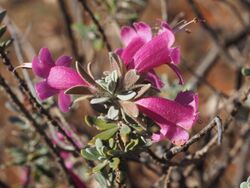Biology:Eremophila glandulifera
| Eremophila glandulifera | |
|---|---|

| |
| Eremophila glandulifera leaves and flowers | |
| Scientific classification | |
| Kingdom: | Plantae |
| Clade: | Tracheophytes |
| Clade: | Angiosperms |
| Clade: | Eudicots |
| Clade: | Asterids |
| Order: | Lamiales |
| Family: | Scrophulariaceae |
| Genus: | Eremophila |
| Species: | E. glandulifera
|
| Binomial name | |
| Eremophila glandulifera Chinnock[1]
| |
Eremophila glandulifera is a flowering plant in the figwort family, Scrophulariaceae and is endemic to Western Australia. It is a small shrub with hairy, grey foliage and attractive deep pink to red flowers usually growing in mulga woodland.
Description
Eremophila glandulifera is an erect shrub growing to a height of between 0.3 and 1 metre (1 and 3 ft) and which has lumpy, hairy branches. Its leaves are mostly 9–18 mm (0.4–0.7 in) long, 4–7 mm (0.2–0.3 in) wide, lance-shaped to egg-shaped and greyish due to a dense covering of star-like hairs.[2][3]
The flowers are borne singly in leaf axils on a hairy stalk, usually 2–4 mm (0.08–0.2 in) long. There are 5 green to purple sepals which are mostly 10–15 mm (0.4–0.6 in) long and hairy on both the inner and outer surfaces. The petals are 25–30 mm (0.98–1.2 in) long and joined at their lower end to form a tube. The tube is deep pink to red with deep red spots inside the top and on the lower petal lobe. The tube and its lobes are hairy on both surfaces, most densely inside the tube. The hairs on the leaves, sepals and petals are often branched and tipped with a gland. The 4 stamens extend beyond the end of the tube. Flowering occurs from May to October and is followed by fruits which are woody with a papery covering and 7–8 millimetres (0.28–0.31 in) long.[2][3]
Taxonomy and naming
The species was first formally described by Robert Chinnock in 2007 and the description was published in Eremophila and Allied Genera: A Monograph of the Plant Family Myoporaceae.[4] The specific epithet is from the Latin glandulifera, 'bearing glands', referring to the glandular hairs of this species.[2][3][4]
Distribution and habitat
Eremophila glandulifera usually grows on stony clay or granite soils, often in mulga woodland in areas between Kalgoorlie and the Mullewa - Carnarvon road in the Murchison and Yalgoo biogeographic regions.[5][6]
Conservation status
Humped fuchsia bush is classified as "not threatened" by the Western Australian Government Department of Parks and Wildlife.[5]
Use in horticulture
The pale pink to bright lipstick pink flowers of this eremophila make it an attractive shrub in a garden. It is easier to propagate by grafting onto Myoporum than by cuttings. It prefers a sunny position but is frost tolerant and has been grown in areas of high humidity such as Sydney.[7]
References
- ↑ "Eremophila glandulifera". Australian Plant Census. https://biodiversity.org.au/nsl/services/apc-format/display/208470. Retrieved 26 July 2019.
- ↑ 2.0 2.1 2.2 Chinnock, R.J. (Bob) (2007). Eremophila and allied genera : a monograph of the plant family Myoporaceae (1st ed.). Dural, NSW: Rosenberg. pp. 495–498. ISBN 9781877058165.
- ↑ 3.0 3.1 3.2 Brown, Andrew; Buirchell, Bevan (2011). A field guide to the eremophilas of Western Australia (1st ed.). Hamilton Hill, W.A.: Simon Nevill Publications. p. 138. ISBN 9780980348156.
- ↑ 4.0 4.1 "Eremophila glandulifera". APNI. http://id.biodiversity.org.au/name/apni/208470. Retrieved 28 January 2016.
- ↑ 5.0 5.1 "Eremophila glandulifera". FloraBase. Western Australian Government Department of Parks and Wildlife. https://florabase.dpaw.wa.gov.au/browse/profile/16475.
- ↑ Paczkowska, Grazyna; Chapman, Alex R. (2000). The Western Australian flora : a descriptive catalogue. Perth: Wildflower Society of Western Australia. p. 336. ISBN 0646402439.
- ↑ Boschen, Norma; Goods, Maree; Wait, Russell (2008). Australia's eremophilas : changing gardens for a changing climate. Melbourne: Bloomings Books. p. 105. ISBN 9781876473655.
Wikidata ☰ Q15595248 entry
 |


